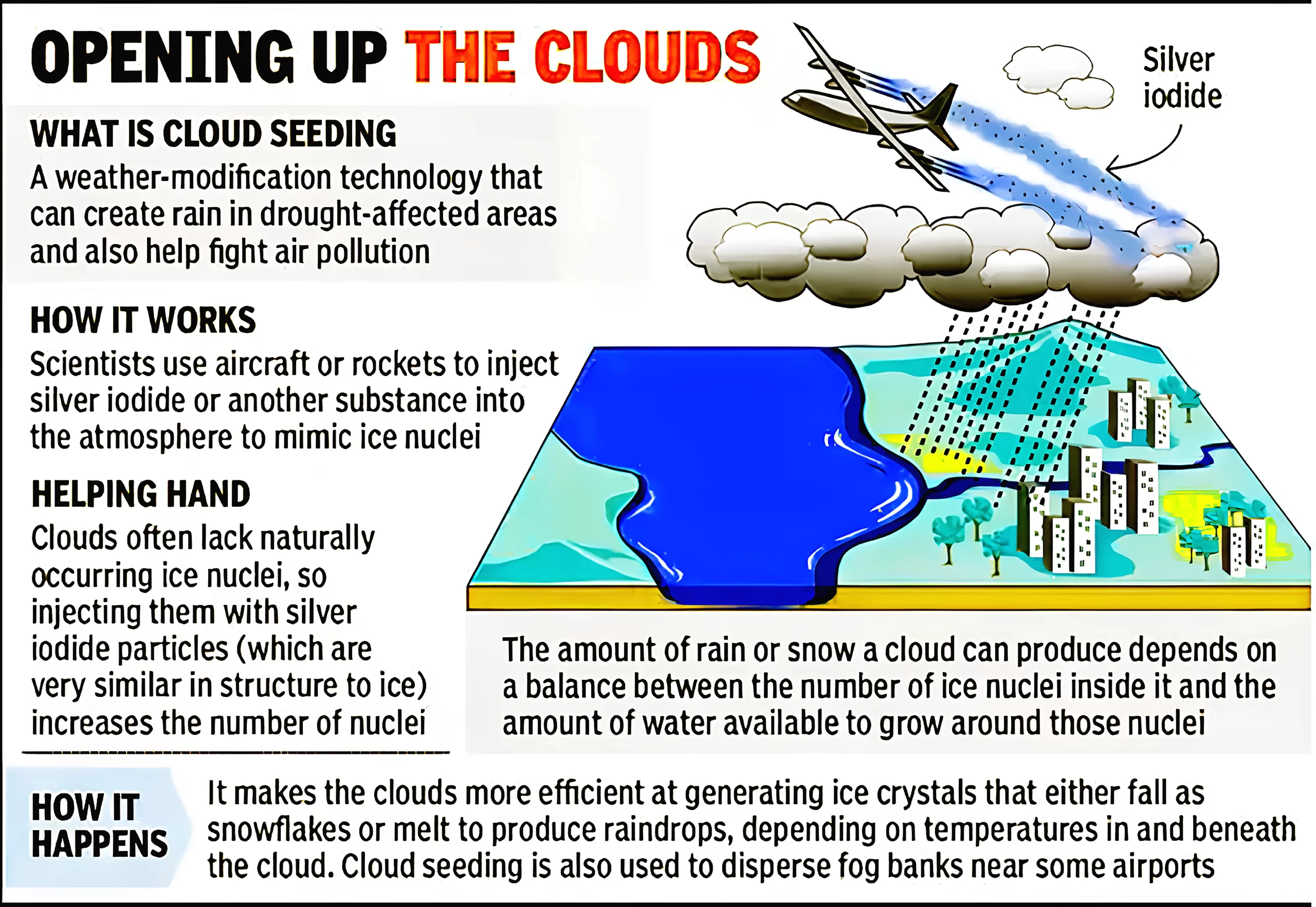- Home
- Prelims
- Mains
- Current Affairs
- Study Materials
- Test Series
 EDITORIALS & ARTICLES
EDITORIALS & ARTICLES
Artificial Rain by Cloud Seeding
Cloud seeding is a kind of weather modification technology to create artificial rain. It works only when there are enough pre-existing clouds in the atmosphere.
Process of cloud seeding for generating artificial rain
|
1. The ‘seeds’ of rain like the iodides of silver or potassium, dry ice (solid carbon dioxide), or liquid propane are inserted into the Clouds. The seeds can be delivered by plane or simply by spraying from the ground. |
 Examples of Use of Cloud Seeding technique to generate artificial rain
Examples of Use of Cloud Seeding technique to generate artificial rain
|
1. UAE- The United Arab Emirates (UAE) has been using the cloud seeding to increase rainfall in their arid region. |
What are the advantages of artificial rain induced by cloud seeding?
- Reduction of air pollution levels-Raindrops capture airborne particulate matter like PM 10 and pollutants like dust, smoke and chemicals. Thus, the pollutants are washed out from the atmosphere by this method. Ex- China employed this to clean Beijing’s air during the Beijing Olympics, 2008.
- Controlling forest fires-In regions prone to wildfires, cloud seeding is used to induce rainfall and help extinguish fires. This, prevents the release of smoke and pollutants into the atmosphere. Ex- Australian Bushfires.
- Agriculture- Artificial rain benefit agriculture by providing much-needed moisture for crops, in drought-stricken areas. Ex- ‘Project Varshadhari’ in Karnataka in 2017.
- Power Generation-Cloud seeding experiments has helped to augment the production of hydroelectricity during the last 40 years in Tasmania, Australia.
- Fog Dispersal, Hail Suppression, and Cyclone Modification- USA launched “Project Sky Water” in 1962 for weather modification through cloud seeding. The project aimed at fog dispersal, hail suppression, and cyclone modification.
- Cloud seeding is done to enhance winter snowfall and increase mountain snowpack, which can supplement the natural water supply for communities in the surrounding area.
- Cloud seeding can also be done to prevent hailstorms, dissipate fog, induce rainfall in drought-prone regions, or reduce air pollution.
What are the challenges associated with the process of Cloud seeding?
- Requirement of moisture-filled clouds-The requirement of clouds laden with a bare minimum moisture is required to start the process of cloud seeding. Ex- Delhi in winters lack moisture laden clouds, making artificial rains difficult to achieve.
- Unintended Environmental Impacts-The chemicals used in the process like the silver iodide or potassium iodide carry the risk of bioaccumulation and potential toxicity. The use of dry ice (solid carbon dioxide) can further contribute to global warming.
- Alteration with the natural weather pattern-Altering weather patterns in one region can affect weather patterns in neighbouring areas, potentially causing droughts or excessive rainfall in unintended places.
- High cost- This method entails huge logistic costs as it involves release of expensive chemicals into the sky with help of flare shots or aircraft.
- International Disputes-Weather systems do not adhere to political borders. Cloud seeding in one region can affect weather patterns in neighbouring countries, leading to potential diplomatic and international concerns.
- Ethical and Legal Challenges-There are ethical concerns about artificially modifying weather patterns, as it may affect the natural balance of ecosystems and disrupt the environment. Legal issues related to liability and compensation for potential damages can also arise in future.
- Cloud seeding requires the presence of moisture-filled clouds, which are not always available or predictable.
Road ahead
Since the cloud seeding technology has several associated risks with it, we must be careful in hastily employing the technology for short term gains. Mentioned below are the ways to move forward-
- Build Scientific consensus- The scientific community must debate on the effectiveness of the technology and build universal consensus on its efficacy. The long-term impact of cloud seeding on ecosystems like water resources, air quality and climate, must be thoroughly researched.
- Evolve proper regulatory mechanism-Proper regulatory mechanism must be evolved to ensure accountability and transparency of these programs.
- Address Public Concerns-The concerns of the public must be addressed before embarking on such ambitious programs.









 Latest News
Latest News General Studies
General Studies